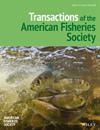Age, growth, and trophic ecology of the Redeye Bass, an introduced invader of California rivers
IF 1.4
3区 农林科学
Q2 FISHERIES
引用次数: 0
Abstract
ObjectiveThe Redeye Bass红眼鲈的年龄、生长和营养生态学--加州河流的外来入侵者
目标红眼鲈(Micropterus coosae)是一种引入加利福尼亚州的食鱼动物,已对该州特有的淡水鱼类构成威胁。红眼鲈已经消灭了我们所研究的科苏梅斯河(Cosumnes River)中游的本地鱼类,科苏梅斯河是美国加利福尼亚州中部萨克拉门托-圣华金河流域主干上没有大坝的最大河流。我们彻底记录了它在加利福尼亚的新生活史和生态学,以揭示为什么尽管它的原生地范围相对较小,却能如此成功地入侵。方法利用 4000 多份稳定碳和氮同位素样本,以及考虑到营养富集数据不确定性的稳定同位素混合模型,完善了我们对鱼类在河流食物网中营养位置的理解。稳定同位素分析表明,红眼鲈在河流生态系统中占主导地位,排斥大多数本地鱼类,占据多个营养级和微生境。成鱼主要捕食非本地小龙虾和大型水生昆虫,而幼鱼则捕食水生昆虫,猎物的大小随红眼鲈的体长而增加。没有食人的证据。红眼鲈有效地占据了至少四种本地鱼类的不同营养位置,并在虹鳟与红眼鲈共存的地点改变了虹鳟的营养位置。
本文章由计算机程序翻译,如有差异,请以英文原文为准。
求助全文
约1分钟内获得全文
求助全文
来源期刊
CiteScore
2.90
自引率
7.10%
发文量
48
审稿时长
8-16 weeks
期刊介绍:
Transactions of the American Fisheries Society is a highly regarded international journal of fisheries science that has been published continuously since 1872. It features results of basic and applied research in genetics, physiology, biology, ecology, population dynamics, economics, health, culture, and other topics germane to marine and freshwater finfish and shellfish and their respective fisheries and environments.

 求助内容:
求助内容: 应助结果提醒方式:
应助结果提醒方式:


